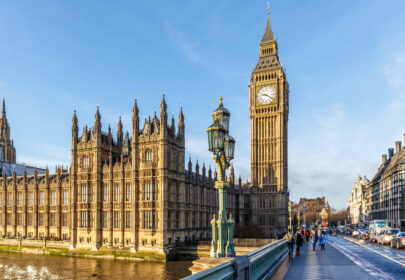Blog
Quarterly Market Update: Are we reaching peak interest rates?

At a glance
- The last quarter was challenging for equity markets, with even large tech companies struggling
- Rising oil prices for much of the quarter presented a challenge for investors
- With inflation falling, eyes are now on central banks to see how much higher interest rates will move
For much of the past year, the big economic story affecting markets has remained the same: inflation is too high, and central banks have been increasing interest rates to try and control it.
During this time, the central interest rate in the UK has jumped from 0.1% to 5.25%1, at the time of writing, with US and Eurozone central banks following a similar pattern.
Traditionally, raising interest rates brings down inflation by slowing spending. Higher interest rates make it more expensive to borrow, which can encourage saving and slow down company investments. With the economy slowing, the theory goes, inflationary pressure should naturally ease. The trade-off is that if the economy slows by too much, Central Banks could push an economy into a recession.
Inflation has generally come down since the interest rates have risen, but they remain above the 2% target of most banks. For example, in the UK inflation remained at 6.7% in August2.
With inflation coming down, towards the end of the quarter several Central Bank decision makers from the US, EU and UK began making noises that interest rates might be approaching their high point.
This could have implications for fixed income investments. Yields typically fall once Central Banks stop increasing interest rates.
If we’re now reaching so called ‘peak rates’, the question is what comes next? Are we looking at a relatively rapid fall back to a low-rate environment, or will they plateau, staying relatively stable for some time?
When good news can be bad news
Part of the issue central bankers are facing is that the US economy is actually performing quite well. It’s GDP grew by over 2% in Q23, and the Federal Reserve Bank of Atlanta has suggested Q3 growth could well be even stronger. Spending remains relatively healthy and, while it has weakened a bit, job data remains positive. The US is expected to achieve the vaunted ‘soft-landing’ that was hoped.
From an investors point of view, this strength means central bankers will feel more comfortable keeping rates higher for longer – which is consistent with the messaging we’re hearing.
This expectation has grown as the Quarter has gone on and, in a case of good news being bad news, has been hurting equity performance.
This has even dampened the performance of the so called ‘mega’ tech companies, such as Apple and Nvidia. They really drove equity performance in the first half of the year; however, the picture wasn’t quite so straightforward in Q3.
For example, Apple dipped notably as the quarter progressed. Performance was also hurt by softer sales, as well as widespread reports that its new iPhone Pro’s were regularly overheating.
The likes of Amazon, Microsoft and even Nvidia – this year’s stock market darling – all saw values recede over the course of September. A critical reminder that share prices can move in both directions.
This general performance wasn’t confined to just tech stocks, however. Both the S&P 500 and the NASDAQ fell over the quarter.
The economic picture isn’t quite so rosy elsewhere. The German economy remains flat, while the Chinese market continues to struggle on the back of issues in the property market.
Meanwhile there was a mixed picture in the UK. At the end of the quarter, the Office for National Statistics reported the UK economy grew as a whole in Q2. On the other hand, we also experienced an unusually rainy July, which put a notable dent in the country’s GDP. Inflationary pressures remain, and Central bankers are also following the ‘higher for longer’ messaging mantra of their US peers.
However, this doesn’t mean the quarter was a bust across equities. The FTSE 100 was just about in the green. The FTSE benefited from featuring several large oil companies. Fuel prices have been increasing over the year as OPEC+ nations cut supply. The price of Brent crude finished the quarter at over $96 a barrel, compared to around $75 at the start4.
While in many ways we remain in a similar situation to where we were three months ago with high inflation and rising interest rates, beneath these headlines the situation is changing. The debates around how long rates will need to stay high, climbing fuel prices and the increasing likelihood of a recession in a major European economy continue to develop, and could well play in important role in how investments perform for the remainder of the year.
Past performance is not a reliable indicator of future performance.
The value of an investment with St. James’s Place will be directly linked to the performance of the funds selected and the value may therefore fall as well as rise. You may get back less than you invested.
Sources
1Interest rates and Bank Rate | Bank of England, date accessed 29/09/2023
2CPI ANNUAL RATE 00: ALL ITEMS 2015=100 – Office for National Statistics (ons.gov.uk) date accessed 29/09/2023
3Gross Domestic Product, Second Quarter 2023 (Second Estimate) and Corporate Profits (Preliminary) | U.S. Bureau of Economic Analysis (BEA) 29/09/2023
4Brent Crude Oil Price Charts | Oilprice.com date accessed 29/09/2023
SJP Approved 11/10/2023
Tea or Coffee?
Why not get in touch to discuss your requirements? We understand that life is busy, that's why we're happy to meet in person or virtually. Let's start to plan your future together.















































































































